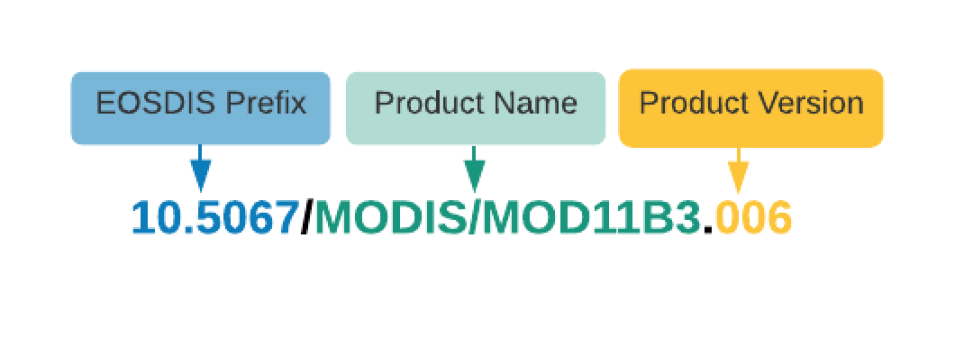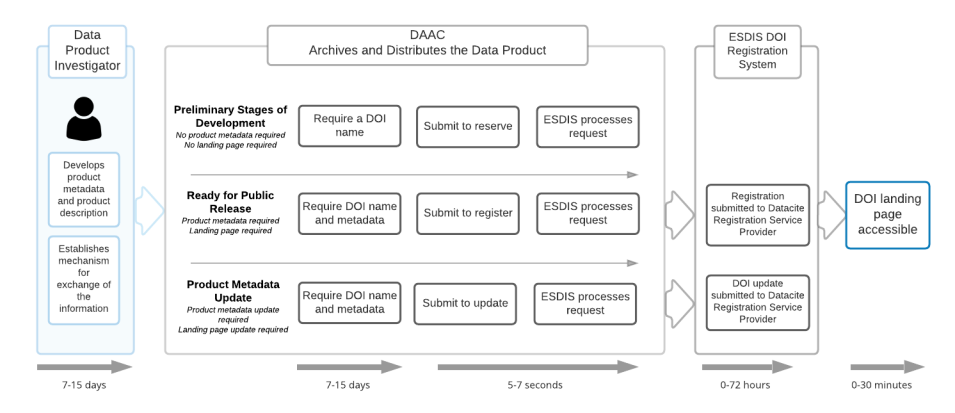What is a DOI and How is it Used?
DOIs, or Digital Object Identifiers, are permanent and unique references to data products in long term storage and distribution spaces. Once registered, a DOI can never be changed or deleted. Because DOIs are fixed, the data products can be found throughout their lifetime, even if their location on the web changes. Each DOI links to a public landing page. NASA’s data archive centers (often referred to as Distributed Active Archive Centers, or DAACs) have a commitment to ensure that those landing pages are present online and actively maintained.
In addition to facilitating data retrieval, DOIs allow researchers to publish citations for the exact data and data products used in their research. Because a DOI is assigned to a specific data product, there is no confusion about which data product or which version of the data product is being cited. Therefore, many journals require DOIs for data citations. The DOI is found on the Additional Information tab of a CMR result page. Computers and humans can also access data product DOIs through various interfaces including Earthdata Search, where it appears with other data product descriptive information.
The Earth Science Data and Information System (ESDIS) Project requires DAACs to publicize citation policies on their websites and in communications accompanying data, including the proper use of DOIs in data citations.
Where Are DOIs Located?
As part of the metadata for a data product, DOIs can be found embedded in the metadata of its science data product, where applicable, and also as part of the data description in metadata repositories such as NASA's Common Metadata Repository (CMR). The DOI is found on the Additional Information tab of a CMR result page. Computers and humans can also access data product DOIs through various interfaces including Earthdata Search, where it appears with other data product descriptive information.
The Anatomy of a DOI
An object’s DOI has two parts: a prefix and a suffix. The prefix begins with the number 10 (which is called a handle and identifies the string of numbers and letters after the 10 as being part of a DOI) followed by a number identifying the organization or agency registering the DOI, called the registration agent. The DOIs for NASA's Earth Observing System Data and Information System (EOSDIS) data products start with 10.5067. The DOI suffix (which is separated from the prefix by a forward slash) uniquely identifies the object, and its format, whether structured or opaque, is assigned and managed by the body or organization submitting the DOI for formal registration, such as ESDIS and the respective DAAC.
For example, the structured DOI assigned to the MODIS/Terra Land Surface Temperature and Emissivity Monthly Level-3 Global 6 km Grid SIN Version 6 product at NASA’s Land Processes DAAC (LP DAAC) is 10.5067/MODIS/MOD11B3.006. The prefix 10.5067 indicates that this is an EOSDIS data product. The suffix MODIS/MOD11B3.006 indicates that this is a MODIS product, the product name is MOD11B3, and this is MODIS Version 6 data. An opaque DOI, on the other hand, has a random collection of characters in the suffix (e.g., 10.5067/uo574Xxry) and does not include information about the work, such as an instrument or product name.
Data Requirements
ESDIS has established criteria to identify EOSDIS data products and supporting documents eligible for a DOI. The data product must be:
- A standard data product, a near real-time (NRT) data product, or documentation related to a data product;
- A data product that is part of a mission, planned for a mission, or already being generated and/or being archived at and distributed by a DAAC.
- A data product supported by NASA's Earth Science Division; or
- Any other data product approved for distribution through a DAAC.
If your product does not meet these criteria, please contact the EOSDIS DOI team.
Metadata Requirements
The DOI is an integral component of data product metadata. The DAAC that archives a data product is responsible for providing ESDIS with the appropriate metadata. Metadata describe or identify the data (e.g., when the data were collected, the instrument used to collect the data, the URL of the data product’s landing page, etc.). Metadata also make it easy to find information about the creation and history of a data product. Specific metadata are required by DataCite (a company used by ESDIS and EOSDIS DAACs to register DOIs) for the registration of EOSDIS data products.
The DOI Assignment Process
If the data product meets the criteria listed in the Data Requirements section (above), a DOI is assigned as part of the data archival process. The assignment process involves three organizations:
- ESDIS manages DOIs as they are created and provides guidance to the DAACs in developing DOI suffixes, ensuring the completeness of DOI names and associated metadata, and reserving, registering, and updating DOIs;
- DAACs provide ESDIS with data product metadata, develop data product landing pages, and provide changes in product metadata or landing page Internet locations; and
- DataCite registers EOSDIS DOIs and provides access to the DOI handling system that enables ESDIS to manage DOIs.
Assignment Timeline
The time required for DOI assignment depends on the availability and accuracy of the information submitted to the DAAC. A time estimate can be given at the DAAC consultation. The image below shows a typical timeline.
Data providers can reserve DOIs prior to the delivery of actual data. Formal registration of DOIs is completed at the end of the archival process. Once DOIs are registered, the data are available to the public.
Getting Started
The DAAC is typically the starting point for the DOI assignment process for data sets that will be delivered to the DAAC. Data providers are notified of DOIs as early as possible, particularly for use in preparing papers.
To initiate the process of requesting a DOI, send an email request to the DAAC responsible for the distribution of your data product. If a DOI is necessary before investigation data are delivered to the assigned DAAC, contact the assigned NASA data repository for assistance. If you have questions about DOI and assignments, contact us.
Other Resources for DOI Registration
If you are not a NASA employee, are registering a non-ESDIS digital product, or unable to get a DOI via the DAAC, there are other options available through FAIRsharing.org. Data should be submitted to discipline-specific, community-recognized repositories when possible, or to generalist repositories if no suitable community resource is available.


